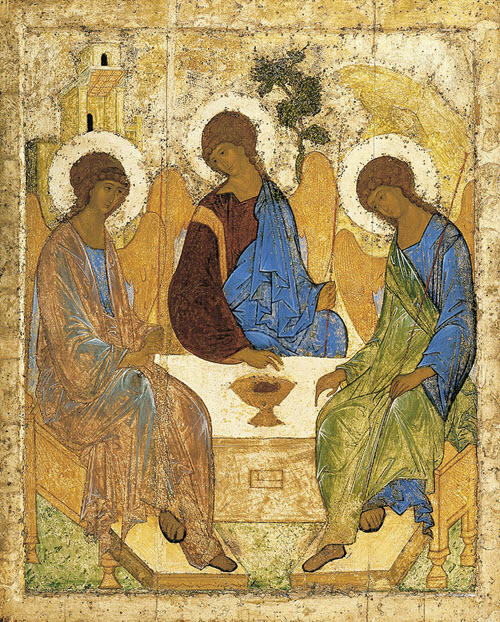Our Life and the Life of the Trinity
 Perhaps the most famous work of art from Russia is Andrey Rublev's Old Testament Trinity. While to see the original you must travel to the Tretyakov Gallery in Moscow, you can find copies of the icon in cathedrals and homes throughout the country. What makes it so relevant and powerful today?
Perhaps the most famous work of art from Russia is Andrey Rublev's Old Testament Trinity. While to see the original you must travel to the Tretyakov Gallery in Moscow, you can find copies of the icon in cathedrals and homes throughout the country. What makes it so relevant and powerful today?
The written image (“written” rather than “painted” because the Orthodox tradition considers to be “theology in color”) is based on the story in Genesis 18 of three angels visiting Abraham and Sarah. When we westerners “read” this famous icon, we are immediately struck by the fact that it is not a typical depiction of the Trinity in Western art - there is no bearded God the Father, no Son on the cross, and no Spirit in the form of a dove.
Paying attention to the details of the images reveals much about how the Eastern church imagines the Trinity. On a basic level, we note three human figures with practicallyl identical faces and bodies. In this way Rublev emphasizes God's unity; at the same time, each of the persons is obviously distinct. The only action in the image lies in their eyes - each is looking in a different direction, but at one another. Their gazes of mutual admiration underline that God is not closed off, but always in relationship.
The most unique aspect of each person of the Trinity is clothing. On the right, the Holy Spirit's garment is blue, wrapped in pale green. These colors point to the movement of the Spirit in the sky and over the waters as well as to the Spirit's life-giving presence.
The Son wears has a thick, heavy garment colored reddish-brown like the earth or blood;the deep blue of the cloak a sign of heaven. In the Son heaven and earth are united; the gold coth of his right shoulder – a sign of his Lordship.
The Father's garments are the most difficult to describe; they seem to be iridescent, made of all colors at once. It is a mystery, as it how it should be, since no one has seen the Father,even if the universe is filled with Divine glory.
The body language of the three figures also holds a lesson. Christ is at the center of the icon, and his gaze is directed at the Father. At the same time his hand is directed toward the Spirit. It seems, then, that the Son is asking the Father to send the Spirit. The Father, in turn, is the only one leaning back as a king might, but He, too is engaged in the "conversation." His hand gives a sign of blessing, and He looks outwards – though it is not clear to whom - to the Spirit? To the Son? Quite possibly the gaze is deliberately ambiguous. The Spirit's posture however, is unequivocal — head bowed humbly before the Father, while the right hand is lowered towards the table, underlining a connection with that which lies outside of God's own interior life.
There are other connections in the icon to our earthly life. For example, each of the figures is holding a staff. Whether the image represents the Triune God or simply reflects the story in Genesis, the figures should have no need for such supports in order to get around. Neither God or angels should need a walking stick! Still for our sake the Divine takes on human weakness in order to make connections with us. The vacant fourth side of the rectangular table is the place for us, the “reader”; the chalice in the center is a sign of our invitation into Communion with God, into the richness of God's grace.
This image of the Trinity inspired the country and its spiritual renewal in the 15th century; it has been returned to again and again throughout Russian history as a sign of the country's unity in diversity..
For us, too, such evocative images of God might be more understandable and relevant than the historical teaching of the Church on the Trinity. Here we see God that is in relationship; God that brings together the heavenly and the earthly, and yet remains shrouded in Mystery. The Trinity invites us to experience Divine Love, and to witness to this grace through putting our faith into action through service of our neighbor. Thank you for doing so in your own places of ministry and through your support of your fellow recipients of God's love in this part of the world.
Your brother in Christ, Bradn Bradn. Dean of the Far East ELCUSFE
 | 